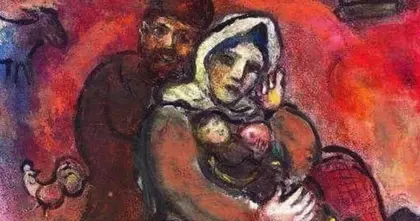From daubed embassy gates and splattered ambassadors to activist “dye-ins” against war crimes – artists and protestors are speaking to the world about Russian culpability and crimes – in red.
In the early 1940s at the height of World War II, the famously Belarusian-French artist Marc Chagall painted “The Ukrainian Family.” This is a work that, for obvious reasons, has been popping up lately on social media and frequently shared. It features a Ukrainian father, mother, and baby holding one another, surrounded by a sea of red and orange. Sky, house, and fields are burning, as the family clings to one another and to survival.
JOIN US ON TELEGRAM
Follow our coverage of the war on the @Kyivpost_official.
Such a palette of overwhelming reds and oranges is of course no accident on the part of an artist, when evoking the horrors of life for civilians in a homeland under attack. Indeed, blood has been a motif in art and cultural output in every war for centuries.
But in terms of the war in Ukraine, our multimedia age and potential to go viral, “blood” has become something unique.
In this war, artistic protests that feature bloody recriminations are intended to paint a stark picture of broken lives and who is to blame: Russia – blood is on your hands and the whole world sees it.
Said artists and activists are not shying away from repeating this message over and over – from posters and paintings to live protests at embassies and choreographed performance pieces around the world.

Drone Wars –Technology, Tactics, Strategy, Countermeasures, Legislation
From the start, international illustrators have provided incisive and startling critique of the sheer bloody brutality of Ukraine’s invaders. In April, The Financial Times’ James Ferguson offered up a political cartoon on Russia’s new status in the world, making clear that Vladimir Putin’s expected fraternal support from China was no longer forthcoming. Ferguson’s cartoon depicts a smiling, bloated Putin, leaning in for an embrace of his pal Xi Jinping. Xi instead recoils in horror from Putin whose hands drip with blood, the front of his suit soaked like a butcher’s apron.
Also in April, artwork appeared addressing what was rapidly becoming, simultaneously, a global horror and global punchline: the embarrassing penchant for looting exhibited by Russian soldiers. In the first few months of the war, these troops were already infamous for sending home blood-soaked criminal spoils – anything from appliances to clothing and toys.
Polish animator Janek Koza pulled no punches in a minimalist cartoon that depicted a Russian solider returning home with a gift for his boy. “I brought you a gift, son – just wash it first”, the soldier explains, as he hands over a toy car soaked in blood.
That same month, a poster pleading with the international community to “SAVE MARIUPOL!” echoed both medieval composition and a color scheme and narrative straight from Chagall’s painting. A woman and baby (reminiscent of a Madonna and child but wrapped in bloody bandages) are shielded by a ring of Ukrainian soldiers. Clamoring at the soldiers’ protective shields is a zombielike horde of Russian aggressors, all depicted in devilish reds – red clothes, hands, and hideously grotesque red faces under red Z helmets.
Live protests, performance, and activism pieces have been no more sparing in reminding Russians of the very real “blood on their hands”. Photos that went viral through March and April depicted the gates of numerous Russian embassies around the world doused with red paint. Stains of shame unable to be washed away, these red paint reprisals still remain, months later, on gates from Prague to Ottawa.
And where red paint isn’t still visible on embassy gates, new bloody reminders are nonetheless being constantly erected. In May, Putin hung as an effigy from a scaffold in front of the Russian embassy in Oslo, hands yet again covered in blood.
Lakes and pools around said embassies have also been turned into starkly accusatory lakes of blood with red dye, as remained in Vilnius, Lithuania for weeks.
Performative and artistic political protest has also grown. Mountains of junk were piled high in front of the Russian embassy’s gates in Warsaw, pointedly filled with the Russians’ preferred looted and shipped items: computer monitors, radios, shoes, televisions, clothes. All were doused in “blood”.
A protest in front of the Russian embassy in Lisbon in April became another work of performance art turned “dye-in”. Set up like a café scene with red tablecloths, the sidewalk was strewn with “gunned-down” civilians dressed in black and punctuated with red scarves for blood.
And in the most famous case of bloody art and activism meeting real-world politics and international attention thus far, “blood” was notoriously thrown at Russia’s ambassador to Poland in May. Sergey Andreev had been attempting to attend a Victory Day wreath-laying ceremony in Warsaw; subsequently videos and photos of Andreev attempting to wipe his face, dripping red, spread around the world.
In response to the perceived insult, the Russian foreign ministry both summoned the Polish ambassador in formal protest and demanded an official apology. To date no apology has been offered.
For four months now, such global-scale art and activism reminding Russia of its genocidal actions has been strong and provocative. Artists are unlikely to stop using creative ways to make their outrage at the horrors of war crimes known; as in Warsaw, apologies should not be expected as forthcoming.
For decades, generations of global citizenry have associated Russia with all things red – red squares, red scares and a red army. But it is likely that in the 21st century, the world’s population will have an entirely different red association with Russia for years to come – red as the color of culpability, guilt, and shame. These metaphorical and literal manifestations of “blood on the hands” will not wash away any time soon.
You can also highlight the text and press Ctrl + Enter






